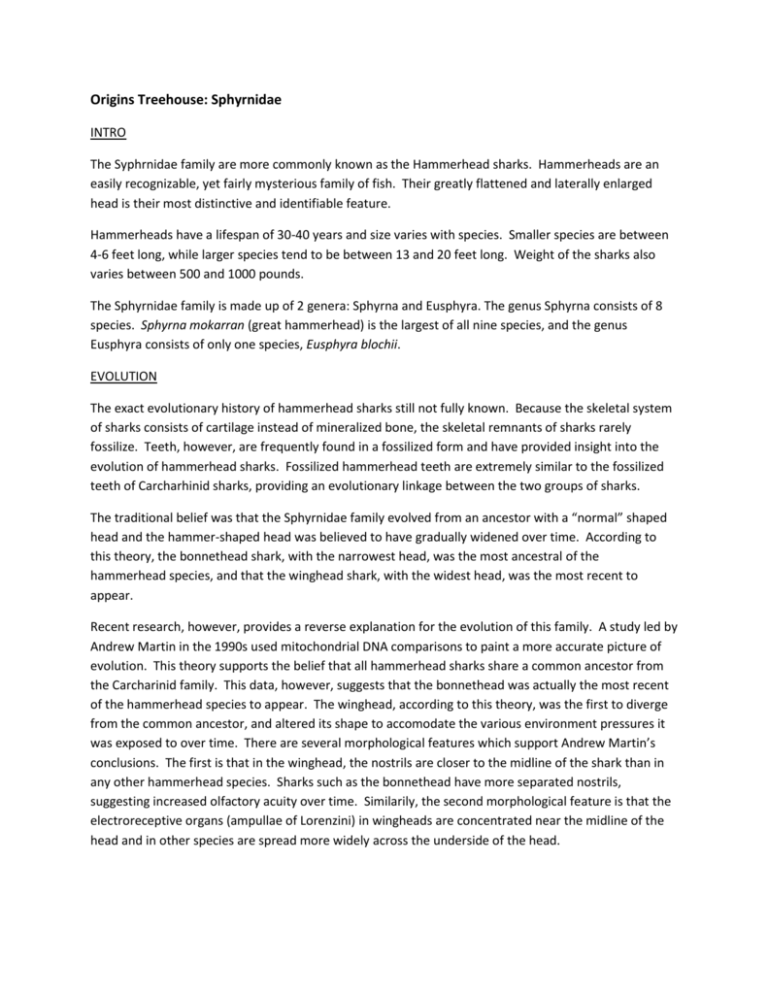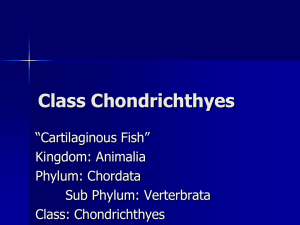Origins Treehouse: Sphyrnidae INTRO The Syphrnidae family are
advertisement

Origins Treehouse: Sphyrnidae INTRO The Syphrnidae family are more commonly known as the Hammerhead sharks. Hammerheads are an easily recognizable, yet fairly mysterious family of fish. Their greatly flattened and laterally enlarged head is their most distinctive and identifiable feature. Hammerheads have a lifespan of 30-40 years and size varies with species. Smaller species are between 4-6 feet long, while larger species tend to be between 13 and 20 feet long. Weight of the sharks also varies between 500 and 1000 pounds. The Sphyrnidae family is made up of 2 genera: Sphyrna and Eusphyra. The genus Sphyrna consists of 8 species. Sphyrna mokarran (great hammerhead) is the largest of all nine species, and the genus Eusphyra consists of only one species, Eusphyra blochii. EVOLUTION The exact evolutionary history of hammerhead sharks still not fully known. Because the skeletal system of sharks consists of cartilage instead of mineralized bone, the skeletal remnants of sharks rarely fossilize. Teeth, however, are frequently found in a fossilized form and have provided insight into the evolution of hammerhead sharks. Fossilized hammerhead teeth are extremely similar to the fossilized teeth of Carcharhinid sharks, providing an evolutionary linkage between the two groups of sharks. The traditional belief was that the Sphyrnidae family evolved from an ancestor with a “normal” shaped head and the hammer-shaped head was believed to have gradually widened over time. According to this theory, the bonnethead shark, with the narrowest head, was the most ancestral of the hammerhead species, and that the winghead shark, with the widest head, was the most recent to appear. Recent research, however, provides a reverse explanation for the evolution of this family. A study led by Andrew Martin in the 1990s used mitochondrial DNA comparisons to paint a more accurate picture of evolution. This theory supports the belief that all hammerhead sharks share a common ancestor from the Carcharinid family. This data, however, suggests that the bonnethead was actually the most recent of the hammerhead species to appear. The winghead, according to this theory, was the first to diverge from the common ancestor, and altered its shape to accomodate the various environment pressures it was exposed to over time. There are several morphological features which support Andrew Martin’s conclusions. The first is that in the winghead, the nostrils are closer to the midline of the shark than in any other hammerhead species. Sharks such as the bonnethead have more separated nostrils, suggesting increased olfactory acuity over time. Similarily, the second morphological feature is that the electroreceptive organs (ampullae of Lorenzini) in wingheads are concentrated near the midline of the head and in other species are spread more widely across the underside of the head. Researchers have narrowed the evolution of this group of sharks down to somewhere within the late Eocene (37-34 million years ago), Oligocene (34-23 million years ago), or early Miocene (23-5 million years ago) epochs. PHYSICAL FEATURES The Sphyrnidae family has very distinct physical characteristics. Their most unique feature is their flattened and laterally extended head. Eyes are located near the outer margin of the head and the sharks have a very well developed third eyelid. Nostrils are located near the front margin of the head. The colour of these sharks varies from grey-brown to olive green, with off-white undersides. Some other features found in hammerhead sharks are distinctive of the Order Carcharhiniformes. These would be the presence of one anal fin and two dorsal fins. One of the most common questions pertaining to hammerhead sharks is: what is the purpose of the hammer-shaped head? The seemingly useless shape has many functions, all of which play a significant role in the shark’s survival. The wide set eyes and nostrils provide the shark with an excellent visual and olfactory range. The head is similar to a hydrodynamic plane and allows the sharks to turn very quickly and sharply. Another contribution to their predatory success is the electroreceptive organs present across the underside of the head. Finally, the head has been observed to be used as an active hunting tool to pin prey down on the bottom of the ocean floor before biting. Hammerheads, in general, have weak teeth. Some variations in teeth exist within the various species of sharks. The great hammerhead has sharper serrated teeth, while the scalloped hammerhead has smooth-edged teeth. The common hammerhead has smooth teeth when young, and slightly serrated teeth which come with maturation. A common trait, in relation to teeth within this family, is that several rows of teeth are present in the jaw. Only the front row is immediately visible, and used for eating. When a shark loses a tooth, another tooth in the subsequent row moves up to replace it. One final feature of sharks is that they have no lungs. Gills are used for the absorption of oxygen from surrounding waters. The method of breathing for sharks involves drawing water in through the mouth and forcing it out through the gills. This process allows for the continual provision of oxygen necessary for survival. HABITAT Hammerhead sharks are widely distributed throughout temperature and tropical waters. They are found most frequently above continental shelves, close to coastal waters. All species of hammerheads migrate seasonally. In the winter months they migrate towards the equator and in the summer months, they migrate towards the poles. The three largest species have the broadest range of marine habitats. The Great and Common Hammerheads tend to swim off of warmer coasts of the Northern and Southern continents. Scalloped Hammerheads prefer tropical waters near the equator. The Winghead species remain limited to Pacific waters, swimming near India and Indonesia. DIET AND EATING HABITS In general, hammerheads tend to eat other fish along with a wide array of cephalopods and crustaceans. The larger species, which have serrated teeth, prefer to eat larger fish, smaller sharks, stingrays, and squid. The smaller species, which have thicker flattened teeth, tend to eat fish, crabs and shrimp. Hammerheads have been shown to exhibit some cannibalistic behaviour, eating other sharks, and also enjoy rays, which are related to sharks. Most feed in shallow coastal waters and some species swim into offshore waters for a nocturnal meal. These sharks have a spiral intestinal valve. The spiral shape means that food passes through the digestive system of this shark extremely slowly. It is for this reason that the sharks do not eat very often, and also have a slower growth rate than other animals. SENSORY SYSTEMS Hammerhead sharks have all five senses present in humans: touch, taste, smell, hearing, and vision. The most acute sense is smell, with the olfactory apparatus accounting for two thirds of total brain weight. Hammerheads can smell blood more than 400 metres away. The nostrils are found near the front margin of the head and are separated, similarly to the eyes, which are also far-set. Their sense of sight is very good as they can see in the dim light of deep water. Even so, eyesight is not very important to sharks until they get very close to their prey. Hammerheads have a unique third eyelid, known as the nictitating membrane, which they can see through. This membrane closes over the eye when the shark encounters danger and also when the shark attacks prey, in order to prevent the prey from damaging their eyes. Sharks have a sixth sense known as electroreception. The ampullae of Lorenzini consist of pores on the underside of the head which can detect electricity coming from the bodies of fish and other marine creatures. Wounded creatures send stronger electrical signals. This feature also helps the sharks with migrating and with movement through water. The ampullae of Lorenzini can detect half of a billionth of a volt. Their hearing is also excellent. Another sense organ is defined as the lateral line. It is a thin strip of sensory cells that runs along the length of the shark’s body on either side. This strip of cells senses sounds made by creatures that are too far away for the ears to detect. REPRODUCTION AND DEVELOPMENT Hammerhead sharks reproduce once a year. In order to court a female shark, the male bites her aggressively until she agrees to mate. Next, the male uses claspers, which are extra fins on his ventral side, which allow him to hold on the female. He inserts his sperm into the opening present on the female’s ventral side. Females are viviparous, meaning that fertilized eggs hatch in the female and she gives birth to live pups. There appears to be a positive correlation between the size of the shark species and the number of pups born. The smaller species, such as the bonnethead, give birth to fewer pups, 8-12. The larger species, such as the great hammerhead, give birth to a greater number of pups, between 20 and 40. The gestation period lasts between 8 and 12 months. The females give birth in shallow coastal waters, in the spring and summer months. The young are born ready to swim and feed, but are not yet fully capable of protecting themselves. After birth, no protection is provided by the parents, and so the pups remain in shallower waters until they are prepared to venture off on their own. BEHAVIOUR Various hammerhead species come together at certain times of the year in specific locations. These meeting places have been identified as the Gulf of California and the Galapagos Islands. The purpose of these meetings is not fully understood, but most liking for group hunting or mating. Scalloped hammerheads, bonnetheads, and smooth hammerheads have been observed to swim in fairly large schools. The small and medium sized hammerheads most likely prefer travelling in schools for protection against larger predators. The great hammerheads are rarely seen with other sharks and prefer to swim alone. Several methods of communication have been observed within this family of fish. They arch their backs, lower their tails, raise their mouths, and corkscrew in the water. Violent head shaking is also seen among large females which swim in the centre of schools. The shaking creates waves which amplify outwards and signal to the smaller females to move to the outer edges of the school. The common belief is that the larger females do this to attract potential mates. Hammerheads, as well as other families of sharks, tend to travel with a small passenger on their underside, the remora fish. This fin has a back fin which acts as a sucker. Their sucker is what allows them to successfully attach to the shark. Hammerhead sharks appear to be completely unbothered by the presence of their hitch-hiker companions, and very rarely eat them. HUMAN RELATIONSHIPS AND CONSERVATION Three species are currently considered to be dangerous to humans: the great hammerhead, the scalloped hammerhead, and the smooth hammerhead. Even though hammerhead sharks are not considered to be very dangerous in general, there have been accounts of larger species attacking people. Most documented attacks were made on individuals who had been spearfishing, and it is believed that it was the blood of the speared fish that attracted the sharks to the fishermen. Hammerhead sharks have shown to be timid and unaggressive when approached by divers. Their teeth are smaller and weaker than the teeth of most other sharks. The Hammerhead shark has been attributed with a total of 33 recorded attacks since 1580 with no deaths. However, similarly to other sharks, hammerhead sharks are often vilified and their evil image is used to justify their slaughter. Sharks are killed for their fins, used in shark fin soup, hides used for leather, oil for vitamins, meat frozen, fresh, dried, smoked for consumption. The following information was obtained from the World Conservation Union’s website. The Sphyrna mokarran (Great Hammerhead) is endangered since 2007 and no species-specific conservation measures have been taken to protect them. The Sphyrna tudes (Smalleye or Golden Hammerhead) has been vulnerable to endangerment since 2006. Other species are at a lower risk, or near threatened status, but this is according to data most recently collected five years ago.








